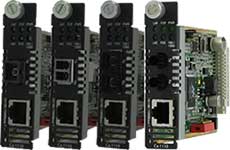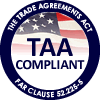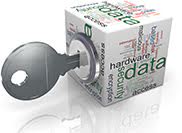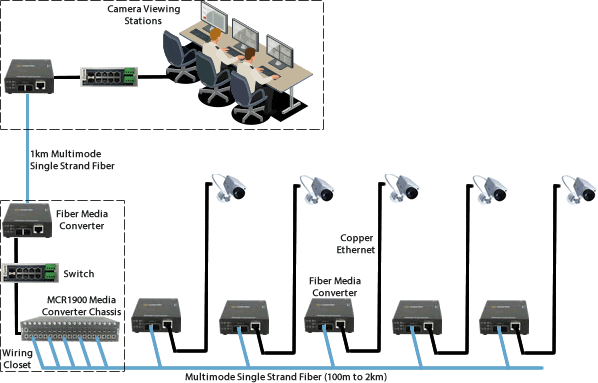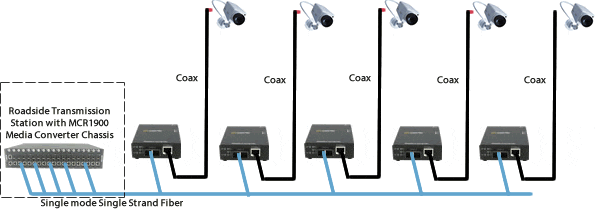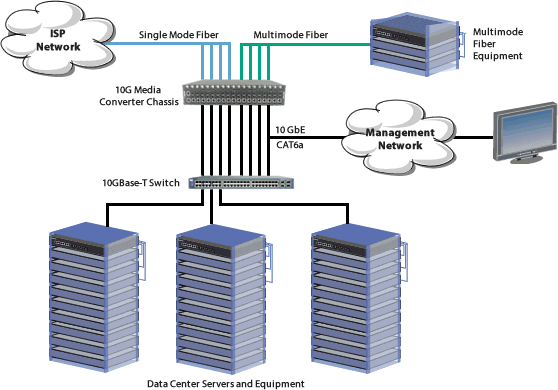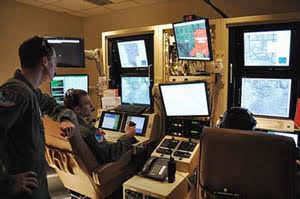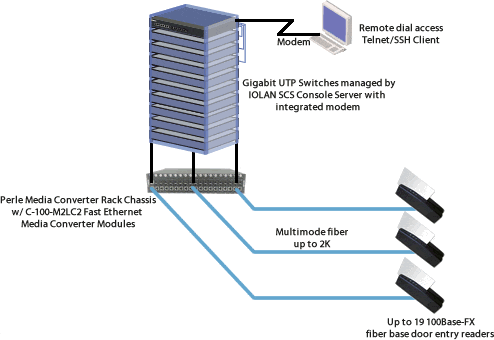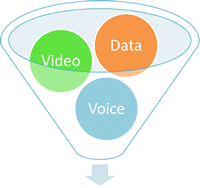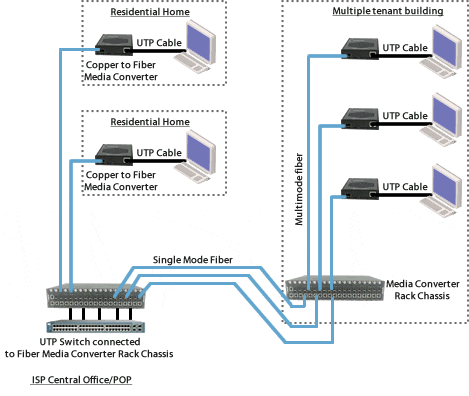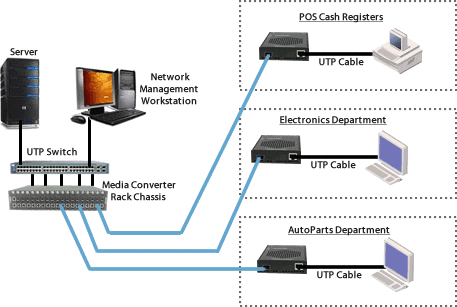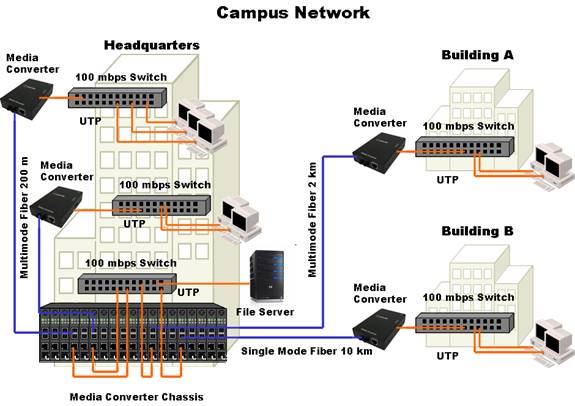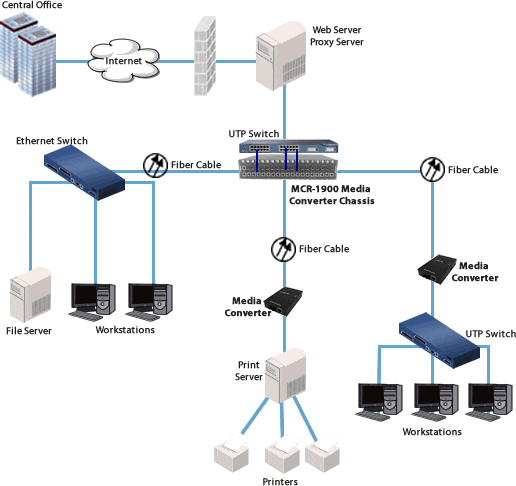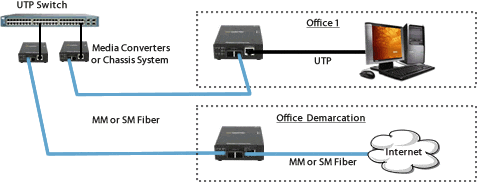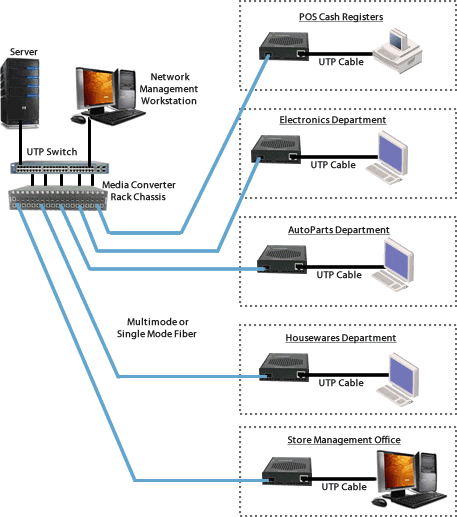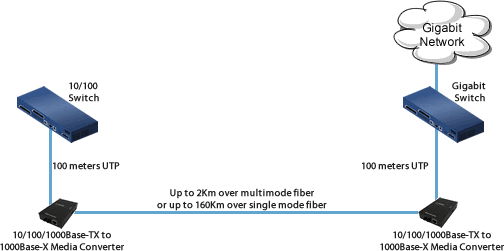CM-110 Managed Fast Ethernet Media and Rate Converter
10/100Base-TX to 100Base-X Conversion
- 10/100Base-TX to 100Base-X Fiber Media Converters
- Extend network distances up to 120km
- Advanced features - Link Pass-Through, Far-End Fault, Auto-MDIX and Loopback
- High density applications with Perle Media Converter Chassis
- Manage via SNMP, CLI - Telnet/SSH, Internet browser, or PerleVIEW Central Management Platform with an MCR-MGT Media Converter Management Module
Installed in a high density Perle Media Converter Chassis, Perle's line of feature rich Managed 10/100 Rate Converting to Fiber Media Converters transparently connect 10/100 Ethernet to fiber. Our 10/100 converters provide an economical path to extend the distance of an existing network, the life of non-fiber based equipment, or the distance between two devices.
Network Administrators can "see-everything" with Perle's advanced features such as Auto-Negotiation, Auto-MDIX, Link Pass-Through, Far End Fault, and Remote Loopback. Along with a Media Converter Management Module in the chassis, configuration and monitoring of the copper and fiber ports can be performed. These cost and time saving features, along with a lifetime warranty and free worldwide technical support, make Perle's Managed 10/100 Ethernet media converter modules the smart choice for IT professionals.
For those environments requiring a medium to large-scale deployment of media converters, a centralized platform that simplifies the configuration, administration, monitoring, and troubleshooting of this gear is recommended. PerleVIEW Device Management software is a multi-user, Windows server-based application that delivers this level of Enterprise-grade solution.
CM-110 Managed Media Converter Features
| QOS (Quality of Service) |
|
| VLAN Tagging |
|
| Unknown Multicast Frame filtering | When enabled, Multicast frames with an unknown destination address are not allowed to egress the port |
| Unknown Unicast Frame filtering | When enabled, Unicast frames with an unknown destination address are not allowed to egress the port |
| Unidirectional Ethernet | When enabled, provides the ability to restrict port to one-way traffic flow. Used in applications such as unidirectional video broadcasting as well as providing security for ethernet connections in accessible public areas |
| Configuration Mode selection | Select whether the module is to use the on-board DIP switches or enable the management module in the chassis to manage |
| Auto-MDIX | Can manually set Auto or MDIX on the copper port via on-board strap or via the management card. Auto-MDIX (automatic medium-dependant interface crossover) detects the signaling on the UTP interface to determine the type of cable connected (straight-through or crossover) and automatically configures the connection when enabled. With Auto-MDIX enabled, either a straight-through or crossover type cable can be used to connect the media converter to the device on the other end of the cable. |
| Module Information |
|
| Module DIP switch settings | View hardware DIP switch settings |
| Selectable Max Packet Size | Set max packet size to 1522, 1518 or 2048 (default) |
| 10BaseT Extended Distance | Normal/extended – default Normal. By configuring as “extended”, the 10baseT receiver sensitivity is increased providing the possibility of an 10BaseT connection greater than 100m. |
| Port Control | Enable or disable individual fiber or copper port on the module |
| Copper Port Status |
|
| Fiber Port Status |
|
| Module Control |
|
| Backup and Restore | Provides fast and easy module replacement. Management module will always save a copy of the media converter configuration and will restore this configuration automatically to the media module when it is detected in the slot |
| Detailed port statistics | To assist in troubleshooting copper and fiber links, an extensive list of ingress and egress counters for both copper and fiber ports are available. These statistics can be viewed locally via the management module or from a central SNMP NMS on the network |
| Auto-Negotiation (802.3u) | The media converter supports auto negotiation on the 10/100Base-TX interface. |
| With Link Pass-Through the state of the UTP receiver is passed to the fiber transmitter to make the media converter appear transparent to the end devices that are connected. In addition if Far-End Fault is enabled the media converter can turn off the 10/100Base-TX transmitter when a FAR-End Fault is received. Using Link Pass-Through with Far-End Fault minimizes data loss when a fault occurs. Should a fault occur, the end devices have the indication of a failure available to them making trouble shooting easier. | |
| Far-End Fault (FEF) | The media converter implements the 802.3 standard for Far-End Fault for the indication and detection of remote fault conditions on the 100Base-X fiber connection. With Far-End Fault enabled the media converter transmits the Far-End Fault Indication over the 100Base-X fiber connection whenever a receive failure is detected on the 100Base-X fiber connection. The media converter continuously monitors the 100Base-X fiber connection for a valid signal. The action the media converter takes on receiving a Far-End Fault Indication is dependent on the Link Pass-Through switch setting. |
| Pause (IEEE 802.3xy) | Pause signaling is an IEEE feature that temporarily suspends data transmission between two devices in the event that one of the devices becomes overwhelmed. The media converter supports pause negotiation on the 10/100Base-TX copper connection. |
| Remote Loopback | The media converter is capable of performing a loopback on the fiber port. |
Specifications
HTSUS Number:
8517.62.0020
UNSPSC Code:
43201553
ECCN:
5A991
Indicators
Power / TST
This green LED is turned on when power is applied to the media converter. Otherwise it is off. The LED will blink when in Loopback test mode.
Fiber link on / Receive activity (LKF)
This green LED is operational only when power is applied. The LED is on when the 100Base-FX link is on and flashes with a 50% duty cycle when data is received.
Copper link on / Receive activity (LKC)
This green LED is operational only when power is applied. The LED is on when the 100Base-TX link is on and flashes with a 50% duty cycle when data is received.
Fiber Duplex (FDF)
This green LED is operational only when power is applied. The LED is on when the 100Base-FX link is operational in full duplex mode. The LED is off when in half duplex.
Copper Duplex (FDC)
This green LED is operational only when power is applied. The LED is on when the 10/100Base-TX link is operational in full duplex mode. The LED is off when in half duplex.
10/100 Speed
This green LED is operational only when power is applied. The LED is on when the speed of the copper Ethernet port is running at 100 MBPS. The LED is off when in 10 MBPS
Switches: On-Board
Auto-Negotiation (802.3u)
- Enabled (Default) - The media converter uses 802.3u Auto-negotiation on the 100Base-TX interface. It is set to advertise full duplex.
- Disabled - The media converter sets the port according to the position of the speed and duplex switches.
Link Pass Through
- Enabled (Default) - When the state of the receiver is changed on the 100Base-TX interface it is reflected on the 100Base-FX fiber transmitter. When the state of the receiver on the 100Base-FX interface is changed it is reflected on the 100Base-TX transmitter.
- When a Far-End Fault Indication is received on the fiber interface the 100Base-TX transmitter is turned off. When the Far-End Fault Indication is cleared the transmitter is turned back on.
- Disabled - Far-End Fault Indications are not transmitted regardless of the condition of the receive signal on the 100Base-FX fiber connection.
Far-End Fault (FEF)
- Enabled Enabled (Default) - The media converter transmits the Far-End Fault Indication over the 100Base-X fiber connection whenever a receive failure is detected on the 100Base-X fiber connection. The media converter continuously monitors the100Base-X fiber connection and clears the Far-End Fault Indication condition when a valid signal is received.
- Disabled - Far-End Fault Indications are not transmitted regardless of the condition of the receive signal on the 100Base-FX fiber connection.
Remote Loopback
The media converter can perform a loopback on the 100Base-X fiber interface.
Disabled (Default - Up)
Enabled - The 100Base-X receiver is looped to the 100Base-X transmitter. The 100Base-TX transmitter is taken off the interface.
Auto-MDIX (Internal Strap)
- If Auto-Negotiation (802.3u) is enabled, the media converter uses the HP Auto-MDIX method for the 100Base-TX interface.
- If Auto-Negotiation (802.3u) is disabled the Media converter will use the RX Energy method on the 100Base-TX interface to set the port MDI or MDIX whichever is appropriate.
- Enabled (Default) - Either a straight-through or crossover type cable can be used to connect the media converter to the device on the other end of the cable.
- Disabled - If the partner device on the other end of the cable does not have the Auto-MDIX feature a specific cable, either a straight-through or crossover will be required to ensure that the media converter's transmitter and the partner devices transmitter are connected to the others receiver. The Media converter's 100Base-TX port is configured as MDI-X with this switch setting.
Speed Copper
- 100 (Default)
- 10
Duplex Copper
- Full (Default)
- Half
Duplex Fiber
- Full (Default)
- Half
Cables
100Base-TX
RJ45 connector, 2 pair CAT 5, EIA/TIA 568A/B or better cable
Magnetic Isolation
1.5kv
Fiber Optic Cable
- Multimode: 62.5 / 125, 50/125, 85/125, 100/140 micron
- Single Mode: 9/125 micron (ITU-T 625)
Filtering
Filtering
1024 MAC Addresses
Frame Specifications
Buffer
512 Kbits frame buffer memory
Size
Maximum frame size of 2048 bytes
Environmental Specifications
Operating Temperature
0°C to 50°C (32°F to 122°F)
Storage Temperature
minimum range of -25°C to 70°C (-13°F to 158°F)
Operating Humidity
5% to 90% non-condensing
Storage Humidity
5% to 95% non-condensing
Operating Altitude
Up to 3,048 meters (10,000 feet)
Heat Output (BTU/HR)
7.2
Maximum Power Consumption (Watts)
2.1
MTBF (Hours)*
598,000 Hours
Calculation model based on MIL-HDBK-217-FN2 @ 30°C
Mechanical - Hot Swapping Card
Edge Connecter
32 pin DIN 41612 / IEC 60603-2 Type B/2 Male. Fist make, last break for ground and power
Card insertion and removal
Captive thumb screws enable fast insertion and removal. Can be further tighten with a screwdriver.
Product Weight
Weight
0.15 kg, 0.33 lbs
Packaging
Shipping Weight
0.33 kg, .73 lbs
Shipping Dimensions
203 x 38 x 152 mm, 8 x 1.5 x 6 inches
Regulatory Approvals
Emissions
- FCC Part 15 Class A, EN55022 Class A
- CISPR 22 Class A
- CISPR 32 / EN 55032
- EN61000-3-2
Immunity
CISPR 35 / EN 55035
Electrical Safety
- UL/EN/IEC 62368-1
- CAN/CSA C22.2 No. 62368-1
- UL 60950-1
- IEC 60950-1(ed 2); am1, am2
- EN 60950-1:2006+A11:2009+A1:2010+A12:2011+A2:2013
- CE
Laser Safety
- EN 60825-1
- Fiber optic transmitters on this device meet Class 1 Laser safety requirements per IEC-60825 FDA/CDRH standards and comply with 21CFR1040.10 and 21CFR1040.11.
Select a Model to obtain a Part Number - Managed Media Converter Chassis Modules - Fast Ethernet to Fiber
| Model | Connector | Type | Transmit (dBm) | Receive (dBm) | Power Budget (dBm) | Wavelength (nm) | Fiber Type | Operating Distance | ||
|---|---|---|---|---|---|---|---|---|---|---|
Min | Max | Min | Max | |||||||
| CM-110-M2ST2 | Dual ST | 100Base-FX | -20.0 | -12.0 | -31.0 | -14.0 | 11.0* | 1310 | MMF | 2 km (1.2 mi) |
| CM-110-M2SC2 | Dual SC | 100Base-FX | -20.0 | -12.0 | -31.0 | -14.0 | 11.0* | 1310 | MMF | 2 km (1.2 mi) |
| CM-110-M2LC2 | Dual LC | 100Base-FX | -20.0 | -12.0 | -30.0 | -14.0 | 10.0* | 1310 | MMF | 2 km (1.2 mi) |
| CM-110-S2ST20 | Dual ST | 100Base-LX | -18.0 | -7.0 | -32.0 | -3.0 | 14.0 | 1310 | SMF | 20 km (12.4 mi) |
| CM-110-S2SC20 | Dual SC | 100Base-LX | -18.0 | -7.0 | -32.0 | -3.0 | 14.0 | 1310 | SMF | 20 km (12.4 mi) |
| CM-110-S2LC20 | Dual LC | 100Base-LX | -15.0 | 0.0 | -34.0 | -5.0 | 19.0 | 1310 | SMF | 20 km (12.4 mi) |
| CM-110-S2ST40 | Dual ST | 100Base-EX | -5.0 | 0.0 | -34.0 | -3.0 | 29.0 | 1310 | SMF | 40 km (25 mi) |
| CM-110-S2SC40 | Dual SC | 100Base-EX | -5.0 | 0.0 | -34.0 | -3.0 | 29.0 | 1310 | SMF | 40 km (25 mi) |
| CM-110-S2LC40 | Dual LC | 100Base-EX | -5.0 | 0.0 | -34.0 | -3.0 | 29.0 | 1310 | SMF | 40 km (25 mi) |
| CM-110-S2ST80 | Dual ST | 100Base-ZX | -5.0 | 0.0 | -34.0 | -3.0 | 29.0 | 1550 | SMF | 80 km (50 mi) |
| CM-110-S2SC80 | Dual SC | 100Base-ZX | -5.0 | 0.0 | -34.0 | -3.0 | 29.0 | 1550 | SMF | 80 km (50 mi) |
| CM-110-S2LC80 | Dual LC | 100Base-ZX | -5.0 | 0.0 | -34.0 | -3.0 | 29.0 | 1550 | SMF | 80 km (50 mi) |
| CM-110-S2ST120 | Dual ST | 100Base-ZX | 0.0 | 5.0 | -35.0 | -3.0 | 35.0 | 1550 | SMF | 120 km (75 mi) |
| CM-110-S2LC120 | Dual LC | 100Base-ZX | 0.0 | 5.0 | -34.0 | -3.0 | 34.0 | 1550 | SMF | 120 km (75 mi) |
| CM-110-S2SC120 | Dual SC | 100Base-ZX | 0.0 | 5.0 | -35.0 | -3.0 | 35.0 | 1550 | SMF | 120 km (75 mi) |
Single Fiber Models (Recommended use in pairs)
| Model | Connector | Type | Transmit (dBm) | Receive (dBm) | Power Budget (dBm) | Wavelength (nm) | Fiber Type | Operating Distance | ||
|---|---|---|---|---|---|---|---|---|---|---|
Min | Max | Min | Max | |||||||
| CM-110-M1ST2U | Single ST | 100Base-BX-U | -15.0 | 0.0 | -28.0 | -8.0 | 13.0 | 1310 / 1550 | MMF | 2 km (1.2 mi) |
| CM-110-M1ST2D | Single ST | 100Base-BX-D | -15.0 | 0.0 | -28.0 | -8.0 | 13.0 | 1550 / 1310 | MMF | 2 km (1.2 mi) |
| CM-110-M1SC2U | Single SC | 100Base-BX-U | -15.0 | 0.0 | -28.0 | -8.0 | 13.0 | 1310 / 1550 | MMF | 2 km (1.2 mi) |
| CM-110-M1SC2D | Single SC | 100Base-BX-D | -15.0 | 0.0 | -28.0 | -8.0 | 13.0 | 1550 / 1310 | MMF | 2 km (1.2 mi) |
| CM-110-S1ST20U | Single ST | 100Base-BX-U | -14.0 | -8.0 | -32.0 | -3.0 | 18.0 | 1310 / 1550 | SMF | 20 km (12.4 mi) |
| CM-110-S1ST20D | Single ST | 100Base-BX-D | -14.0 | -8.0 | -32.0 | -3.0 | 18.0 | 1550 / 1310 | SMF | 20 km (12.4 mi) |
| CM-110-S1SC20U | Single SC | 100Base-BX-U | -14.0 | -8.0 | -32.0 | -3.0 | 18.0 | 1310 / 1550 | SMF | 20 km (12.4 mi) |
| CM-110-S1SC20D | Single SC | 100Base-BX-D | -14.0 | -8.0 | -32.0 | -3.0 | 18.0 | 1550 / 1310 | SMF | 20 km (12.4 mi) |
| CM-110-S1SC40U | Single SC | 100Base-BX-U | -8.0 | -3.0 | -33.0 | -3.0 | 25.0 | 1310 / 1550 | SMF | 40 km (25 mi) |
| CM-110-S1SC40D | Single SC | 100Base-BX-D | -8.0 | -3.0 | -33.0 | -3.0 | 25.0 | 1550 / 1310 | SMF | 40 km (25 mi) |
The minimum fiber cable distance for all converters listed is 2 meters.
*Based on use with 62.5/125 micron multimode fiber.
Application Diagrams
High Density Fiber Distribution from UTP Switch Equipment at Corporate Headquarters
In this enterprise campus application, up to 18 Perle CM-110 10/100 Ethernet to Fiber Media Converters are installed in the MCR1900 Media Converter Chassis. The 19th slot in the chassis is filled the MCR-MGT Management Module. All media converts in the chassis are managed by SNMP, Telnet or an internet browser interface. A remote fiber enabled Ethernet switch is connected directly to the central MCR1900 Chassis. A standalone S-110 Media Converter converts the fiber to Ethernet in a fiber-to-desktop application. Another S-110 Fiber Media Converter is connected to a remote office Ethernet switch. In all cases, multimode or single-mode fiber can be used. Fiber links can be extended up to 120km using single-mode fiber.
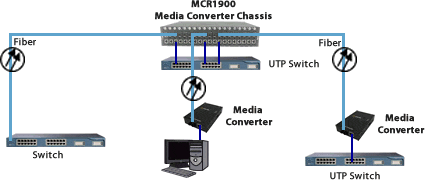
Ethernet to Fiber in a Campus Network
The use of chassis-based media converters is a cost effective means in providing fiber connectivity in a campus network. By consolidating Ethernet to fiber conversion in a rack mount media converter chassis, various types of fiber links can be brought into a single wiring closet platform. This simplifies deployment and maintenance and also provides a scalable means to grow your network as needed.
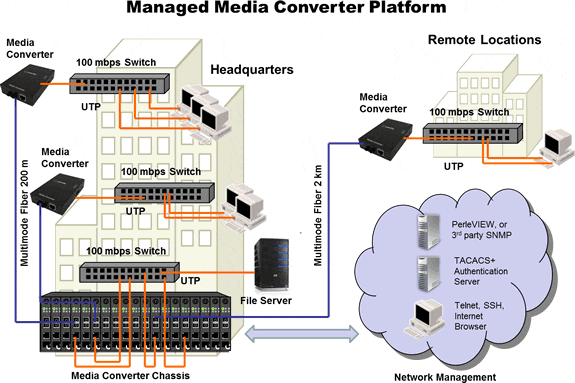
Managed Ethernet over Fiber Links
Manage your copper to fiber link with an MCR200 chassis housing a media converter and management module. Ideal for use in managed networks with low density fiber applications, this Managed Media Converter is connected across a fiber link to a remote media converter. The copper or fiber link on the managed standalone unit can provide vital information and status to network management tools such as SNMP.
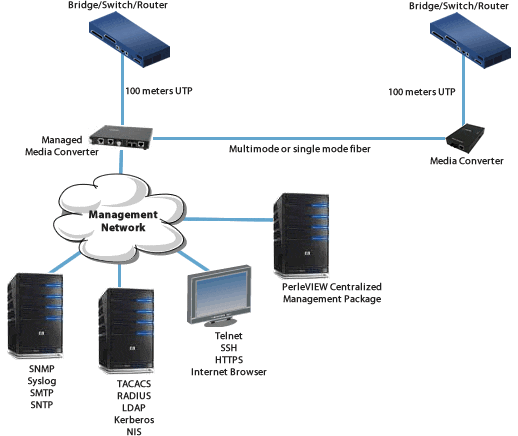
10/100 – Extend Network between Ethernet Hubs
A pair of 10/100 media converters can extend the distance between hubs across a fiber link up to 120km in length.
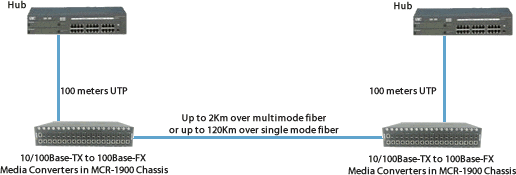
10/100 – Extend Network between 10Mbps and Fast Ethernet
A pair of 10/100 media converters can extend the distance between a legacy 10Mbps device to a Fast Ethernet switch across a fiber link up to 120km in length.
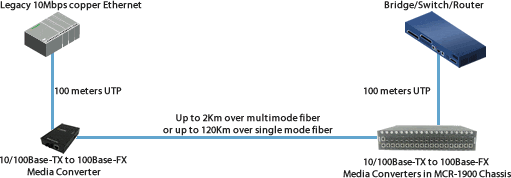
10/100 – Extend Network between Half-Duplex Hubs
A pair of 10/100 media converters can extend the distance between hubs across a fiber link up to 120km in length. They also isolate the collision domains, associated with half-duplex, from crossing the fiber link.
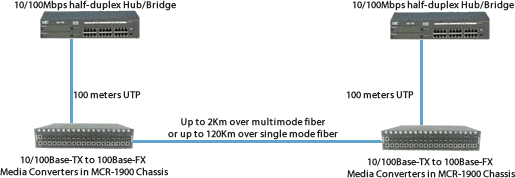
10/100 – Extend Network between Half-Duplex Hub and Switch
A pair of 10/100 media converters can extend the distance between a half-duplex hub and a full-duplex switch across a fiber link up to 120km in length. They also isolate the collision domains, associated with half-duplex, from crossing the fiber link. In this scenario, the media converter connected to the switch must be forced to half-duplex.
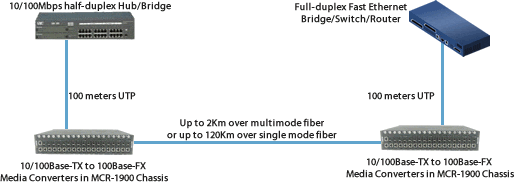
10/100 – Extend Network between two legacy 10Mbps Devices
A pair of 10/100 media converters can extend the distance between two legacy 10Mbps devices across a fiber link up to 120km in length.
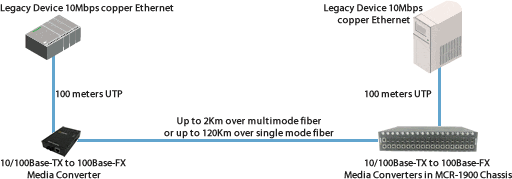
Single Mode / Single Fiber
When Single Strand fiber is used, a pair of Single Fiber Media Converters is needed for the copper to fiber conversion. Perle Single Fiber Media Converters are also referred to as “Up/Down” models. For example the CM-110-S1SC20U (“Up”) and CM-110-S1SC20D (“Down”), shown below, must be used in pairs. An “Up” must be matched with a “Down” peer to deal with transmit and receive frequencies separately.

CM-110-S1SC20UCM-110-S1SC20D
The majority of installations for single mode fiber media converters are of the “dual connector” or “dual fiber” type where one fiber connection is used for transmit, the other for receive. These are physically “crossed” to match up the Transmit/Receive links.
However, to reduce costs, or where there are limits on available fiber, WDM technology may be utilized. WDM uses separate transmit and receive frequencies to communicate on a single fiber strand. WDM technology relies on the fact that optical fibers can carry many wavelengths of light simultaneously without interaction between each wavelength. Thus, a single fiber can carry many separate wavelength signals or channels simultaneously.
So remember, if Single Strand fiber is used, you will need an “Up” Media Converter on one side and a “Down” Media Converter on the other for copper to fiber conversion.
Perle offers a wide variety of Single Fiber (“Up/Down”) Media Converters to connect 10BaseT, Fast Ethernet and Gigabit to single fiber. Whether you need Managed or Unmanaged, Standalone or Modular Chassis Based, 20km or 120km, Perle has the right model to meet your fiber conversion requirement.
Filter your options to find the right hardware for your application
Viewing 25 of 25 products
Click on a part number for ordering information
Product Image
Product Description
Part No.

CM-110-M2ST2 - 10/100 Fast Ethernet Media and Rate Converter Managed Module. 10/100Base-TX (RJ-45) [100 m/328 ft.] to 100Base-FX 1310nm multimode (ST) [2 km/1.2 miles]. Managed or unmanaged operation

CM-110-M2SC2 - 10/100 Fast Ethernet Media and Rate Converter Managed Module. 10/100Base-TX (RJ-45) [100 m/328 ft.] to 100Base-FX 1310nm multimode (SC) [2 km/1.2 miles]. Managed or unmanaged operation

CM-110-M2LC2 - 10/100 Fast Ethernet Media and Rate Converter Managed Module. 10/100Base-TX (RJ-45) [100 m/328 ft.] to 100Base-FX 1310nm multimode (LC) [2 km/1.2 miles]. Managed or unmanaged operation

CM-110-S2ST20 - 10/100 Fast Ethernet Media and Rate Converter Managed Module. 10/100Base-TX (RJ-45) [100 m/328 ft.] to 100Base-LX 1310nm single mode (ST) [20 km/12.4 miles]. Managed or unmanaged operation

CM-110-S2SC20 - 10/100 Fast Ethernet Media and Rate Converter Managed Module. 10/100Base-TX (RJ-45) [100 m/328 ft.] to 100Base-LX 1310nm single mode (SC) [20 km/12.4 miles]. Managed or unmanaged operation

CM-110-S2LC20 - 10/100 Fast Ethernet Media and Rate Converter Managed Module. 10/100Base-TX (RJ-45) [100 m/328 ft.] to 100Base-LX 1310nm single mode (LC) [20 km/12.4 miles]. Managed or unmanaged operation

CM-110-S2ST40 - 10/100 Fast Ethernet Media and Rate Converter Managed Module. 10/100Base-TX (RJ-45) [100 m/328 ft.] to 100Base-EX 1310nm single mode (ST) [40 km/24.9 miles]. Managed or unmanaged operation

CM-110-S2SC40 - 10/100 Fast Ethernet Media and Rate Converter Managed Module. 10/100Base-TX (RJ-45) [100 m/328 ft.] to 100Base-EX 1310nm single mode (SC) [40 km/24.9 miles]. Managed or unmanaged operation

CM-110-S2LC40 - 10/100 Fast Ethernet Media and Rate Converter Managed Module. 10/100Base-TX (RJ-45) [100 m/328 ft.] to 100Base-EX 1310nm single mode (LC) [40 km/24.9 miles]. Managed or unmanaged operation

CM-110-S2ST80 - 10/100 Fast Ethernet Media and Rate Converter Managed Module. 10/100Base-TX (RJ-45) [100 m/328 ft.] to 100Base-ZX 1550nm single mode (ST) [80 km/49.7 miles]. Managed or unmanaged operation

CM-110-S2SC80 - 10/100 Fast Ethernet Media and Rate Converter Managed Module. 10/100Base-TX (RJ-45) [100 m/328 ft.] to 100Base-ZX 1550nm single mode (SC) [80 km/49.7 miles]. Managed or unmanaged operation

CM-110-S2LC80 - 10/100 Fast Ethernet Media and Rate Converter Managed Module. 10/100Base-TX (RJ-45) [100 m/328 ft.] to 100Base-ZX 1550nm single mode (LC) [80 km/49.7 miles]. Managed or unmanaged operation

CM-110-S2ST120 - 10/100 Fast Ethernet Media and Rate Converter Managed Module. 10/100Base-TX (RJ-45) [100 m/328 ft.] to 100Base-ZX 1550nm single mode (ST) [120 km/74.6 miles]. Managed or unmanaged operation

CM-110-S2SC120 - 10/100 Fast Ethernet Media and Rate Converter Managed Module. 10/100Base-TX (RJ-45) [100 m/328 ft.] to 100Base-ZX 1550nm single mode (SC) [120 km/74.6 miles]. Managed or unmanaged operation

CM-110-S2LC120 - 10/100 Fast Ethernet Media and Rate Converter Managed Module. 10/100Base-TX (RJ-45) [100 m/328 ft.] to 100Base-ZX 1550nm single mode (LC) [120 km/74.6 miles]. Managed or unmanaged operation

CM-110-M1ST2U - 10/100 Fast Ethernet Media and Rate Converter. Managed Module 10/100Base-TX (RJ-45) [100 m/328 ft.] to 100Base-BX 1310nm TX / 1550nm RX single strand fiber, multimode (ST) [2 km/1.2 miles]. Managed or unmanaged operation

CM-110-M1ST2D - 10/100 Fast Ethernet Media and Rate Converter. Managed Module 10/100Base-TX (RJ-45) [100 m/328 ft.] to 100Base-BX 1550nm TX / 1310nm RX single strand fiber, multimode (ST) [2 km/1.2 miles]. Managed or unmanaged operation

CM-110-M1SC2U - 10/100 Fast Ethernet Media and Rate Converter Managed Module. 10/100Base-TX (RJ-45) [100 m/328 ft.] to 100Base-BX 1310nm TX / 1550nm RX single strand fiber, multimode (SC) [2 km/1.2 miles]. Managed or unmanaged operation

CM-110-M1SC2D - 10/100 Fast Ethernet Media and Rate Converter Managed Module. 10/100Base-TX (RJ-45) [100 m/328 ft.] to 100Base-BX 1550nm TX / 1310nm RX single strand fiber, multimode (SC) [2 km/1.2 miles]. Managed or unmanaged operation

CM-110-S1ST20U - 10/100 Fast Ethernet Media and Rate Converter. Managed Module 10/100Base-TX (RJ-45) [100 m/328 ft.] to 100Base-BX 1310nm TX / 1550nm RX single strand fiber, single mode (ST) [20 km/12.4 miles]. Managed or unmanaged operat

CM-110-S1ST20D - 10/100 Fast Ethernet Media and Rate Converter. Managed Module 10/100Base-TX (RJ-45) [100 m/328 ft.] to 100Base-BX 1550nm TX / 1310nm RX single strand fiber, single mode (ST) [20 km/12.4 miles]. Managed or unmanaged operat

CM-110-S1SC20U - 10/100 Fast Ethernet Media and Rate Converter Managed Module. 10/100Base-TX (RJ-45) [100 m/328 ft.] to 100Base-BX 1310nm TX / 1550nm RX single strand fiber, single mode (SC) [20 km/12.4 miles]. Managed or unmanaged operat

CM-110-S1SC20D - 10/100 Fast Ethernet Media and Rate Converter Managed Module. 10/100Base-TX (RJ-45) [100 m/328 ft.] to 100Base-BX 1550nm TX / 1310nm RX single strand fiber, single mode (SC) [20 km/12.4 miles]. Managed or unmanaged operat

CM-110-S1SC40U - 10/100 Fast Ethernet Media and Rate Converter Managed Module. 10/100Base-TX (RJ-45) [100 m/328 ft.] to 100Base-BX 1310nm TX / 1550nm RX single strand fiber, single mode (SC) [40 km/24.9 miles]. Managed or unmanaged operat

CM-110-S1SC40D - 10/100 Fast Ethernet Media and Rate Converter Managed Module. 10/100Base-TX (RJ-45) [100 m/328 ft.] to 100Base-BX 1550nm TX / 1310nm RX single strand fiber, single mode (SC) [40 km/24.9 miles]. Managed or unmanaged operat
